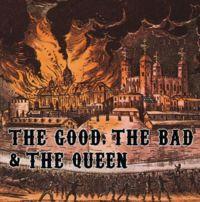Call it the effect of an ocean between us, but the work of Damon Albarn has been fairly inconsequential in my life. In North America it's easy to see Blur and Gorillaz as just two more imported mainstream rock acts, just as easy to avoid as they are to discover. Of course that's not at all true in the UK, where I suspect for many Albarn's profile is the sole reason the Good, The Bad & The Queen are so high on the radar. Around here, or more specifically within the confines of these four walls, it's exclusively due to the participation of one Paul Simonon. This is the Clash bassist's return to music, and that's going to bring a whole lot of attention from certain quarters that wouldn't give a new Albarn project a second thought. What can I say? They were the only band that mattered.
Yet while Simonon's the hook, this is inarguably Albarn's project. The Blur frontman sings lead and plays keyboard, and while it's uncredited the lyrics likely his as well. Verve guitarist Simon Tong rounds out a base of accomplished Brit-pop veterans. Simonon of course provides the lows, but also contributes backing vocals and serves as the in-house visual artist. Nigerian drummer Tony Allen is perhaps the most interesting member of the quartet, as the Afrobeat founder's been described (by Brian Eno no less) as "perhaps the greatest drummer who has ever lived." While Albarn's got the track record (and ego) afforded by pop success, Allen helped create a genre -- and that adds a certain amount of credibility to what may otherwise be seen as a vanity project. Yet for all the gravity attached to the members' pasts the band has legitimately coalesced; the "supergroup" label even feels like a misnomer.
The album's a downer, purposely so. The band takes a restrained, atmospheric approach, painting life in modern London with a thick layer of fog. Interestingly underlying Albram's oft-whispered vocals are dub rhythms courtesy of Simonon and Allen. Considering how the Clash progressed from "Armagideon Time" onwards this material is perfectly suited to Simonon's reggae-informed playing. The coupling of such a pulsing, active low end with a melancholy, pensive facade sets the record apart. It's remarkably organic, surprisingly so with a star producer like Danger Mouse involved. If the DJ, infamous for his remix projects, would have taken a heavier hand to the work it would have fallen too close to Gorillaz in terms of style. Instead he leaves the musicians mostly to themselves, adding some tasteful percussion and synths here and there, but never overstating his presence. The band's key strength is in retaining that sense of minimalism, and the record doesn't feel busy or overwrought despite a number of session players contributing. The latter half of the album's awash in strings and the single "Herculean" employs a 16-piece choir, yet the sense of intimacy remains. Once the band exhausts the dub formula they tease with some fascinating departures, primarily the curious, captivating White Album pop of "Green Fields."
While "History Song" and "Kingdom of Doom" were presented as such there isn't much in the way of obvious singles on The Good, The Bad & The Queen, and that suits the overall mood of the record. The album, quite heavily orchestrated and featuring the personalities it does, feels like an exercise in restraint. The result is a remarkably smart, moody and oft downtrodden pop record that's informed by the members' past work but not shackled by it.
